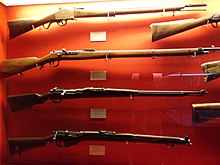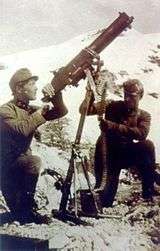Kropatschek rifle
A Kropatschek is any variant of a rifle designed by Alfred von Kropatschek. Kropatschek's rifles used a tubular magazine (constructed of nickel-plated steel) of his design, of the same type used in the German Mauser Gewehr 1871/84 and the Japanese Type 22 Murata. While designed for black powder, the Kropatschek action proved to be strong enough to handle smokeless powder.
| Kropatschek/Steyr-Kropatschek | |
|---|---|
 Portuguese Kropatschek (Second from top) | |
| Type | Rifle |
| Place of origin | Austria-Hungary |
| Service history | |
| In service | 1886–1898 (Portugal) |
| Used by | Kingdom of Portugal Austria-Hungary France |
| Wars | Second Boer War World War I Spanish Civil War World War II (Portuguese colonies) Annexation of Goa Portuguese Colonial War |
| Production history | |
| Designed | 1886 |
| Produced | 1886–ca. 1898 |
| Variants | Long rifles, short rifle |
| Specifications | |
| Mass | 4.3 kg (9.5 lb) |
| Length | 1320 mm (4 ft) |
| Barrel length | 820 mm (32.3 in) |
| Cartridge | 8×60mmR Guedes[1] 8×56mmR Kropatschek Corto[2] |
| Caliber | 8mm (.323 in) |
| Action | Bolt action |
| Muzzle velocity | 609 m/s (2,000 ft/s) |
| Effective firing range | 2406 yd (2,200 m) |
| Feed system | 8-round integral tubular magazine |
The Kropatschek was the basis for the French Lebel Rifle.[3]
Variants
- Gendarmerie Repetier-Karabiner M1881: 11 mm Gendarmerie Carbine (also known as M1874/81);
- Kropatschek Torpedo Boats Gewehr M1893: 8 mm Navy Rifle for Torpedo boat crews.
France:
- Fusil de Marine Mle 1878: 11 mm Navy Rifle;
- Fusil d'Infanterie Mle 1884: 11 mm Infantry Rifle;
- Fusil d'Infanterie Mle 1885: 11 mm Infantry Rifle.
Portugal:
- Espingarda de Infantaria 8 mm m/1886: 8 mm Infantry Rifle;
- Carabina de Caçadores 8 mm m/1886: 8 mm Light Infantry Carbine;
- Carabina de Cavalaria 8 mm m/1886: 8 mm Cavalry Carbine;
- Carabina da Guarda Fiscal 8 mm m/1886/88: 8 mm Treasury Guard Carbine;
- Espingarda de Infantaria 8 mm m/1886/89: 8 mm Colonial Infantry Rifle;
- Carabina de Artilharia 8 mm m/1886/91: 8 mm Artillery Carbine.
gollark: ++exec --debug```pythonprint("hi")```
gollark: ++exec --debug```pythonprint("hi")```
gollark: ++exec --debug```pythonprint("hi")```
gollark: ++exec```pythonprint("hi")```
gollark: I don't get it. The debug thing works totally on the bot's end and yet "connection error"?
See also
References
External links
- French 1878 Marine Kropatschek Forgotten Weapons
This article is issued from Wikipedia. The text is licensed under Creative Commons - Attribution - Sharealike. Additional terms may apply for the media files.
